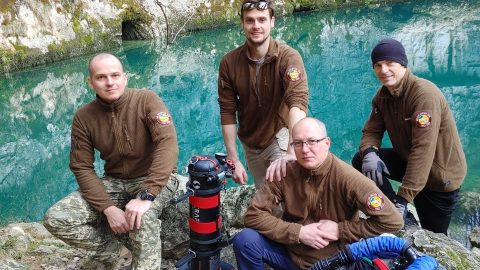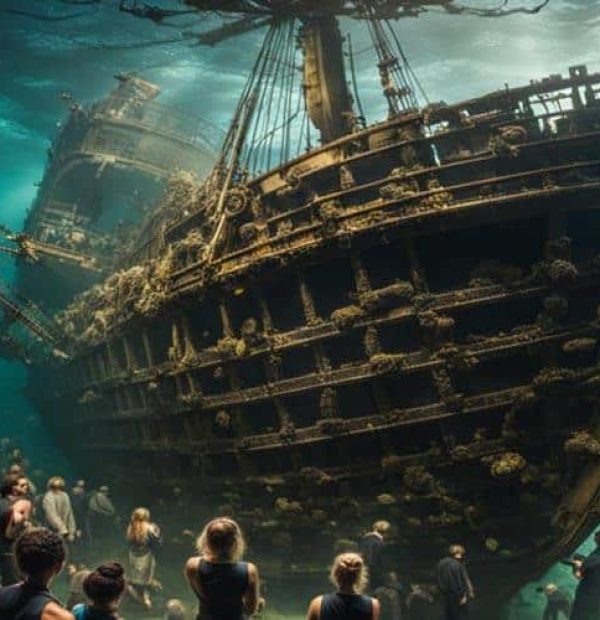Wednesday, 15 May 2024
Menu

The search was conducted as part of a joint project between a Finnish diving and search team SubZone and the Russian Underwater Search Team Разведывательно-водолазная команда. The work ended with the location of the sinking site and the exploration and identification of the wreck of the destroyer “Novik”, near the Estonian cape Juminda.
The wreck lies at a depth of 75 metres in the middle of the Gulf of Finland. The hull of the vessel was broken into two parts as a result of an explosion caused by hitting a mine. The bow section is raised, while the stern, with the main guns and superstructure, rests evenly on the keel. On the wreck you can clearly see the name of the ship, which was on it at the time of sinking – “Yakov Sverdlov”, and also the coat of arms of the USSR.
The likely site of the ship’s sinking was pinpointed by Russian historian Mikhail Ivanov, who identified it from German archival material. The documents contained data about a depth charge bombardment in 1943, against a certain object that the Germans recognized as a Soviet submarine (it was later assumed that it might be Shch-406), but as is known today, Sch-406 sank near the island of Bolshoy Tyuters (Tytärsaari).
A sonar search by Immi Wallin, head of SubZone, found a destroyer-like wreck with clearly visible guns on the aft deck. This was enough to send a team of divers to the bottom to inspect and possibly identify the wreck.
The dive was conducted on 16 June 2018, from the research vessel “Yoldia”. A team comprising Immi Wallin, Pasi Lammi, Mikhail Ivanov, Konstantin Bogdanov and Innokenty Olkhovoy identified the ship, finding the name “Yakov Sverdlov” and the Soviet Union’s coat of arms on the stern. The three 102mm main guns, located on the aft deck, were examined, as well as the distinctive stern of the “Novika” with its spare steering wheel and machine telegraph.
An examination of the ship’s breaking point was carried out, revealing that the legendary vessel had been virtually torn in two by a powerful mine explosion in the area of the second funnel.
The destroyer was sunk on August, 28th, 1941 during the evacuation of Tallinn while escorting the cruiser “Kirov”. The reason of sinking was entering of the German-Finnish mine field “Juminda”.
The construction of the destroyer began with the laying of the keel in 1910 in the Petersburg shipyard Putilovsky Plant. The ship was finished on September, 9th, 1913. “Novik” was the first destroyer built in its class. It was 102.4 meters long and 9.5 meters wide, with the draught of 7.2 meters.
During World War I it was the fastest ship on Earth, developing a speed of 37.3 knots, and one of the most modern. The Novik class destroyers were also the first to run on oil instead of coal.
During the ongoing civil war in Russia, in November, 1917, the crew of “Novik” goes to the side of Bolsheviks, who in 1923 rename it to “Yakov Sverdlov”.
Source: SubZone, Разведывательно-водолазная команда
Photo: Innokenty Olkhovoy










Welcome to DIVERS24.COM, your daily source of scuba news, freediving, scuba diving information, and equipment reviews. Our comprehensive coverage of the dive industry from A to Z provides you with all the latest scuba news, training updates, underwater photography tips, and everything else related to scuba diving. Whether you’re a beginner or an experienced diver looking for more knowledge about scuba gear or techniques – we’ve got it covered! With our in-depth articles written by experienced divers who have been there and done that, you are sure to find exactly what you need here at Divers24.com. Dive into scuba news today!
Underwater Media Sp. z o.o.
Szafarnia 11/F8,
80-755 Gdansk, Poland
Welcome to DIVERS24.COM, your daily source of scuba news, freediving, and scuba diving information. Sign in for a weekly news update and discount coupons for dive gear and apparel.
@2023 - underwatermedia.pl. All Right Reserved. Designed and Developed by Tworzenie stron internetowych Gdansk

The Divers24 portal is currently the largest online medium treating diving in Poland. Since 2010 we have been providing interesting and important information from Poland and around the world on all forms of diving and related activities.
Contact us: info@divers24.com